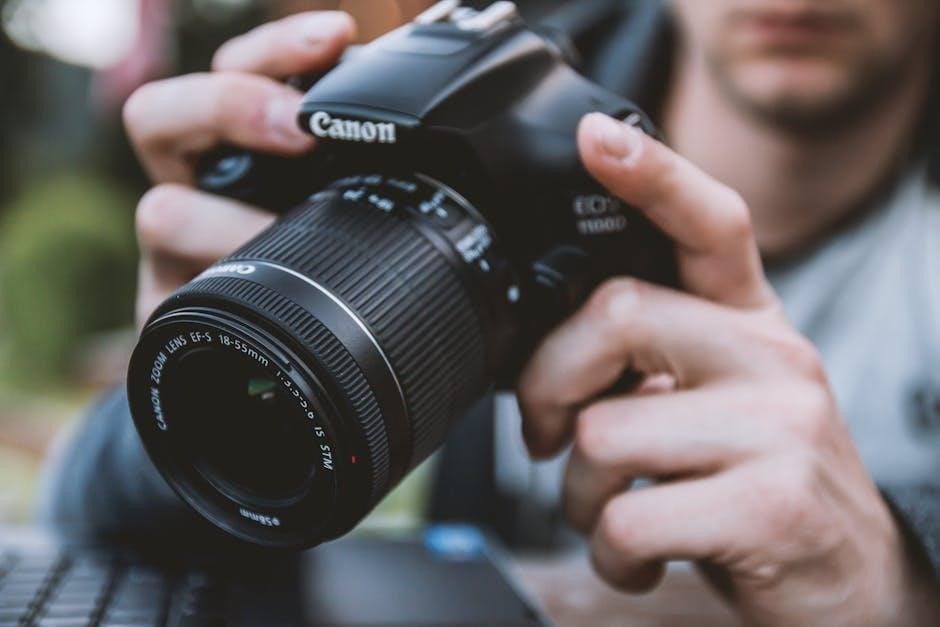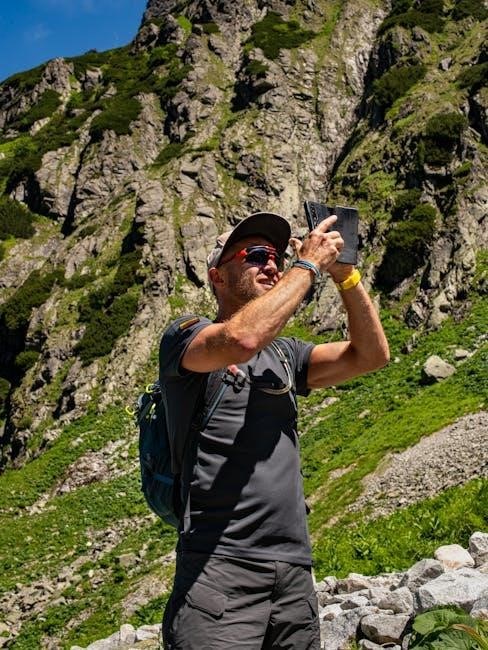Welcome to the comprehensive manual for your 4K trail camera! This guide provides essential instructions for setting up, operating, and optimizing your high-resolution outdoor camera.
Overview of the 4K Trail Camera Features
Your 4K trail camera is designed to capture stunning 4K Ultra HD videos and 48MP photos, ensuring crisp and detailed imagery. It features advanced night vision with infrared LEDs, allowing for clear captures in low-light conditions. The camera includes a motion sensor with adjustable sensitivity, ensuring accurate detection of movement. With a fast trigger speed, it quickly captures images of wildlife or intruders. It is weather-resistant, making it durable for outdoor use, and operates efficiently in temperatures from 0°C to 60°C (32°F to 104°F). Additionally, it supports 4G LTE connectivity for remote monitoring, offering flexibility for hunters, wildlife enthusiasts, and property owners. These features make it an ideal choice for surveillance and outdoor photography.
Importance of Reading the Manual
Reading the manual is crucial for understanding your 4K trail camera’s full potential. It provides detailed instructions for proper setup, ensuring optimal performance in various environments. The manual explains how to format memory cards, configure motion sensors, and adjust video resolution for crystal-clear captures. It also highlights essential maintenance tips, such as cleaning the lens and protecting the camera from extreme temperatures. By following the manual, you can avoid common issues like battery drain or incompatible accessories. This guide helps you troubleshoot problems and maximize the camera’s longevity. Whether for wildlife monitoring or security, understanding the manual ensures you get the most out of your 4K trail camera.

Unboxing and Accessories
Unboxing your 4K trail camera reveals essential accessories like the camera, batteries, memory card, USB cable, and mounting hardware, ensuring you’re ready for immediate setup and use.
What’s Included in the Package
Your 4K trail camera package typically includes the camera unit, a 32GB SD card, four AA batteries, a micro USB cable, a stand mount, and three bolts for secure attachment. Additional accessories may vary by brand, with some models offering an adjustable belt for versatile mounting options. Ensure all components are accounted for to facilitate a smooth setup process. The provided hardware enables quick installation and operation, while the memory card ensures ample storage for high-resolution images and videos. Refer to the packaging list for specific inclusions tailored to your camera model.

Understanding the Camera Components
Familiarizing yourself with the camera’s components is crucial for optimal use. The camera features a high-resolution lens for capturing 4K images and videos, along with an infrared motion sensor for detecting wildlife. The LCD screen displays settings and previews, while the control buttons allow easy navigation. The memory card slot and battery compartment are located on the side, supporting up to 32GB of storage and powered by four AA batteries. A mounting belt is included for securing the camera to trees or stands. LED indicators, such as a flashing red light, signal proper motion sensor functionality. Understanding these elements ensures efficient setup and operation.

Installation and Mounting
The camera can be mounted using the adjustable belt or stand. Push one end through the slots on the back, then tighten securely. Adjust the angle as needed for optimal positioning and stability.
Mounting Methods for the Trail Camera
Your 4K trail camera offers versatile mounting options to suit various environments. The adjustable belt is a common method, allowing easy attachment to trees or poles. Simply thread one end through the camera’s back slots and secure it tightly; Alternatively, use the included stand mount for flat surfaces, ensuring stability with the provided bolts. Both methods enable quick adjustments to the camera’s angle and direction, ensuring optimal coverage. Proper mounting is crucial for capturing clear images and videos, especially in outdoor settings where stability is key to performance. Always ensure the camera is level and firmly secured to minimize movement and vibrations. This ensures reliable operation and high-quality results in all conditions.
Adjusting the Camera Angle and Direction
Adjusting the angle and direction of your 4K trail camera ensures optimal coverage of your target area. Begin by loosening the mounting bracket to allow movement. Tilt the camera up or down and rotate it left or right to achieve the desired field of view. Use the adjustable belt or stand mount to secure the camera firmly. Check the red light on the infrared sensor to confirm it is facing the correct direction. Fine-tune the angle to avoid obstructions like branches or uneven terrain. Ensure the camera is level to prevent tilted images. Proper alignment ensures clear and focused photos and videos, maximizing the camera’s performance in any setting. Adjustments should be made carefully to avoid missing important activity. Always test the camera’s view before finalizing its position. This step is crucial for capturing high-quality footage and photos. By carefully adjusting the angle and direction, you can ensure your trail camera operates effectively and delivers reliable results. Regular checks and adjustments will help maintain optimal performance over time.

Initial Setup and Configuration
Start by formatting the memory card in the camera or on a computer to ensure proper functionality. Insert the formatted card and set the date, time, and basic settings. Properly insert the batteries or connect the power source, ensuring they are compatible with the camera. These steps ensure your 4K trail camera is ready for reliable performance and high-quality image capture.
Inserting the Memory Card and Formatting
To ensure optimal performance, insert the memory card into the camera’s card slot, located on the side or rear, depending on the model. Gently push the card until it clicks into place. Formatting the memory card is crucial to prevent malfunctions. Use the camera’s menu to format the card or do it on a computer. This step erases all data, so back up important files beforehand. A formatted card ensures smooth operation, proper file storage, and prevents errors during recording or photo capture. Always use a high-quality card compatible with your 4K trail camera for best results.
Setting Up Battery and Power Options
Insert the batteries by opening the camera’s battery compartment, typically located on the bottom or rear. Use 4x AA batteries, ensuring they are inserted correctly following the polarity markings. Avoid using 1.2V rechargeable batteries, as they may drain quickly or cause performance issues. For extended use, consider high-capacity batteries. If using a solar panel or external power source, connect it according to the manufacturer’s instructions. Always check that the camera’s power saving features are enabled to prolong battery life. Ensure the camera is turned off when not in use to conserve energy. Proper power management ensures reliable operation in the field.

Advanced Settings and Customization
Explore advanced features like motion sensor adjustments, video/photo resolution settings, and custom capture modes to tailor your 4K trail camera for specific monitoring needs.
Configuring Motion Sensor Sensitivity
Adjusting the motion sensor sensitivity ensures accurate detection of movement. Access the settings menu to select from low, medium, or high sensitivity levels. For wildlife monitoring, high sensitivity captures even slight movements, while lower settings reduce false triggers. Test the camera by walking in front of it to observe detection range and accuracy. Ensure the sensor is clean and free from obstructions for optimal performance. Avoid placing the camera near moving objects like trees or water to minimize unwanted activations. Proper calibration ensures reliable operation in various environments, enhancing the camera’s effectiveness for surveillance or nature observation. Regularly check and adjust sensitivity based on specific monitoring needs.
Setting Video and Photo Resolution
Customize your camera’s resolution to suit your needs. For high-quality images, set the photo resolution to 48MP, capturing crisp details. Video resolution can be adjusted to 4K at 30fps for smooth, ultra-high-definition footage. Lower resolutions, like 1080p, conserve storage space and battery life. Access the settings menu to select preferred resolutions. Ensure the memory card is formatted and compatible with high-resolution settings. Balancing quality and storage capacity ensures efficient use of resources. Regularly check resolution settings to adapt to different environments or subjects, optimizing your camera’s performance for wildlife monitoring or security purposes.

Testing and Troubleshooting
Ensure your camera is functioning properly by checking the red light flash for motion sensor activation. Troubleshoot common issues like battery drain or low sensitivity by formatting the memory card and adjusting settings as needed.
Checking Camera Functionality
To ensure your 4K trail camera operates correctly, start by verifying the power status and checking for the red light flash, which indicates the motion sensor is active. Next, format the memory card in the camera’s settings or on a computer to prevent malfunctions. Test video and photo resolution by capturing sample footage and reviewing it. Check the camera’s angle and direction to ensure proper coverage. Finally, confirm that the camera is functioning in the correct mode (e.g., photo, video, or hybrid). If issues arise, refer to the troubleshooting section for solutions to problems like battery drain or sensitivity adjustments.

Common Issues and Solutions
One frequent issue is rapid battery drain, often due to high sensitivity settings or non-compatible batteries. Replace with recommended 1.2V rechargeable batteries and adjust sensitivity. If the camera fails to record, ensure the memory card is properly formatted and not full. For motion sensor malfunctions, check if the infrared LEDs are clean and unobstructed. If video recording time is inconsistent, review resolution settings, as higher settings may reduce recording duration. Always refer to the user manual for specific troubleshooting steps to resolve these issues effectively and maintain optimal camera performance in various outdoor conditions. Regular maintenance can also prevent such problems.

Maintenance and Care
Regularly clean the lens and camera casing to prevent dirt or moisture damage. Avoid extreme temperatures (0°C to 60°C) for optimal performance. Ensure proper storage and handling.
Cleaning and Protecting the Camera
Regular cleaning is crucial for maintaining your 4K trail camera’s performance. Use a soft, dry cloth to wipe the lens and casing to prevent dirt or moisture buildup. Avoid harsh chemicals or abrasive materials that might damage the surfaces. For stubborn smudges, lightly dampen the cloth with water, but ensure it is thoroughly dry before wiping the camera. Store the camera in a dry, cool place when not in use to protect it from extreme temperatures and humidity. Avoid exposing the camera to direct sunlight for extended periods, as this can cause overheating. Proper care ensures longevity and optimal functionality. Always handle the camera with care to prevent scratches or damage.
Operating Temperature Guidelines
Your 4K trail camera is designed to operate effectively within a specific temperature range. The recommended operating temperature is between 0°C (32°F) and 60°C (140°F). Avoid exposing the camera to extreme cold or heat, as this may affect battery performance or damage internal components. In freezing conditions, ensure the camera is properly insulated or housed in a protective case. Similarly, in hot environments, avoid direct sunlight exposure for extended periods to prevent overheating. Moisture should also be avoided, as it can compromise the camera’s functionality. Always check the operating temperature guidelines in the manual to ensure optimal performance and longevity of your device.

Accessories and Enhancements
Explore compatible accessories like rechargeable batteries, memory cards, and mounting brackets. Optional enhancements include tree mounts and protective cases for improved functionality and durability.
Compatible Batteries and Chargers
Your 4K trail camera requires specific batteries for optimal performance; Use 1.5V alkaline or NiMH rechargeable batteries. Note that 1.2V rechargeable batteries are not compatible, as they may cause issues like rapid drainage or reduced sensitivity. For extended use, consider high-capacity NiMH batteries, which offer longer operation in the field. Always use a reliable charger to maintain battery health.
The camera operates within a temperature range of 0°C to 60°C (32°F to 104°F). Using original or high-quality third-party chargers ensures safety and efficiency. Avoid mixing old and new batteries to prevent performance inconsistencies. Proper battery care enhances camera reliability and longevity.
Optional Mounts and Accessories
Enhance your trail camera setup with optional mounts and accessories for improved functionality. Use the provided adjustable belt to secure the camera to trees or posts. For added stability, consider a stand mount or additional bolts for various surfaces. A micro USB cable is included for charging and data transfer.
Optional accessories like solar panels can extend battery life, especially for long-term monitoring. Extra memory cards ensure continuous recording without interruptions. Explore compatible mounts for different environments to maximize your camera’s versatility and performance in the field. These accessories are designed to enhance your outdoor surveillance experience.
Final Tips for Optimal Use
To ensure your 4K trail camera performs at its best, position it at a height of 2-3 feet for optimal detection. Always format the memory card before use to prevent errors. Check battery compatibility and avoid using 1.2V rechargeable batteries, as they may drain quickly. Adjust motion sensor sensitivity based on your environment to reduce false triggers. Clean the camera lens regularly to maintain image clarity. For long-term use, ensure the camera operates within the recommended temperature range of 0°C to 60°C (32°F to 104°F). Regularly update settings and refer to the manual for troubleshooting common issues.
Where to Find Additional Support
For further assistance, visit the official website of your camera’s manufacturer, such as K F CONCEPT, DARGAHOU, or Campark, where detailed user manuals are available for download. Many brands also offer dedicated customer support teams via email or phone for troubleshooting. Additionally, online forums and communities, like those for outdoor enthusiasts or photography experts, can provide valuable tips and solutions. Refer to the user manual for specific contact information or support links. Ensure to check the manufacturer’s official page for the latest updates and resources to enhance your 4K trail camera experience and resolve any issues efficiently.